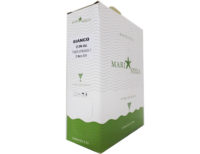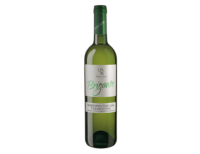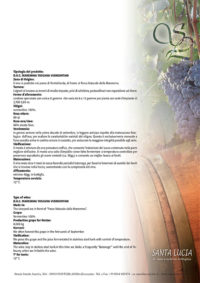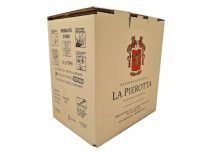THE VERMENTINO “VARIETY” The etymological interpretations of the term Vermentino are somewhat nebulous and above all do not fully explain why this white berried grape was named in this way. The most accredited interpretation argues that the name can be connected to the term “worm” which indicates a young, flexible and thin twig. Regardless of the history of the name, Vermentino has often been confused with other descriptions of the grape variety: the most exemplary case is found in a writing dated 1834 where Vermentino and Vernaccia are spoken indiscriminately and where the same author, however, gives a clear location of origin in Liguria, only to be denied by other texts where it is argued that the landing in the region is only an arrival station departing from the Iberian peninsula via French Provence. Currently it is also widespread in Sardinia, with the DOCG Vermentino di Gallura and throughout the territory of Tuscany. THE “WINE” VERMENTINO From the 60s to the end of the 70s of the last century, Vermentino was used almost exclusively as a table grape and very little for winemaking. With the improvement of techniques in the countryside and in the cellar, it was subsequently possible to produce wines with a good broad and elegant bouquet with notes of fresh fruit, citrus fruits and white flowers supported by a full and balanced taste, good acidity and fine sapidity.
-
- Sardinia wines
BAG-IN-BOX WHITE WINE 12% SARDEGNA – 5 LITRES
- 31.50€
- Cantina Santa Maria la Palma, from the lands of Sardinia, GRAPES: VERMENTINO DI GALLURA and MALVASIA, COLOR: straw yellow with slight greenish reflections, BOUQUET: thin, intense and delicate, TASTE: alcoholic, soft with a slightly bitter aftertaste, MATCHING: Sardinian pecorino and Sardinian flower, clams soup, stewed beans and grilled fish.
- Add to cart
-
- Tuscany wines
BAG-IN-BOX WHITE WINE TOSCANA IGT 12.5% – 5 LITRES
- 28.20€
- Azienda Santa Lucia, from the lands of Morellino di Scansano, GRAPES: vermentino and ansonica, COLOR: straw yellow, BOUQUET: fresh, floral, characteristic, TASTE: fresh, mineral, fruity, COMBINATIONS: fish hors d'oeuvres, first courses and fish soups, baked fish
- Add to cart
-
- Tuscany wines
BAG-IN-BOX WHITE WINE TOSCANA IGT 12.5% – 3 LITRES
- 19.20€
- Azienda Santa Lucia, from the lands of Morellino di Scansano, GRAPES: vermentino and ansonica, COLOR: straw yellow, BOUQUET: fresh, floral, characteristic, TASTE: fresh, mineral, fruity, COMBINATIONS: fish hors d'oeuvres, first courses and fish soups, baked fish
- Add to cart
-
- Out of Stock
- Tuscany wines
BAG IN BOX WHITE WINE TOSCANA IGT from BOLGHERI 12,5% – 5 LITRES
- Fattoria Casa di Terra, from the hills of Bolgheri, GRAPES: Vermentino COLOR: bright straw yellow, BOUQUET: characteristic fruity, dry and savory, TASTE: mineral, dry, harmonious, fresh, PAIRING: seafood appetizers, first courses and fish soups , fish and carpaccio.
- Read more
-
-
- Sardinia wines
BAG-IN-BOX WHITE WINE 12% SARDEGNA – 3 LITRES
- 20.90€
- Cantina Santa Maria la Palma, from the lands of Sardinia, GRAPES: VERMENTINO DI GALLURA and MALVASIA, COLOR: straw yellow with slight greenish reflections, BOUQUET: thin, intense and delicate, TASTE: alcoholic, soft with a slightly bitter aftertaste, MATCHING: Sardinian pecorino and Sardinian flower, clams soup, stewed beans and grilled fish.
- Add to cart
-
WHITE WINE Maremma Toscana DOC Vermentino “Brigante” 13% – 750 ml
- 19.80€
- Company Santa Lucia, from the lands of Morellino di Scansano, White GRAPES: Vermentino, CHARACTERISTICS: bright straw yellow color, characteristic bouquet, floral, dry taste, harmonious and mineral.
- Add to cart
-
- Tuscany wines
BAG-IN-BOX WHITE TUSCANY from Massa Marittima 13% – 5 LITERS
- 28.20€
- Azienda La Pierotta from the hills of Massa Marittima, GRAPES: sangiovese, syrah and merlot, COLOR: straw yellow with greenish reflections, BOUQUET: fresh, floral, characteristic TASTE: warm, mineral, dry and slightly savory, PAIRINGS: appetizers and seafood first courses , fried fish, baked fish.
- Add to cart










